| Figure 1: The aggregated responses from the graphical method (bottom) compared to the distributions rapidly presented to subjects at the start of the experiment, which is the normative distribution (top). |
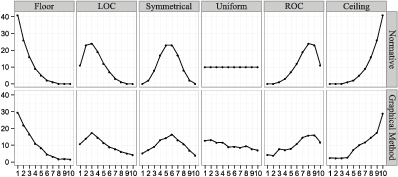
Judgment and Decision Making, Vol. 9, No. 1, January 2014, pp. 1-14
Lay understanding of probability distributionsDaniel G. Goldstein* David Rothschild* |
How accurate are laypeople’s intuitions about probability distributions of events? The economic and psychological literatures provide opposing answers. A classical economic view assumes that ordinary decision makers consult perfect expectations, while recent psychological research has emphasized biases in perceptions. In this work, we test laypeople’s intuitions about probability distributions. To establish a ground truth against which accuracy can be assessed, we control the information seen by each subject to establish unambiguous normative answers. We find that laypeople’s statistical intuitions can be highly accurate, and depend strongly upon the elicitation method used. In particular, we find that eliciting an entire distribution from a respondent using a graphical interface, and then computing simple statistics (such as means, fractiles, and confidence intervals) on this distribution, leads to greater accuracy, on both the individual and aggregate level, than the standard method of asking about the same statistics directly.
Keywords: probability, polling, graphical interface, distribution,
expectation, frequencies, biases.
How accurate are laypeople’s statistical intuitions about probability distributions? Turning to the literature, economics and psychology seem to provide opposing answers to this question. Classical economics assumes people arrive at perfect expectations, while psychological research has emphasized that perceptions of means and variances are subject to many biases. For example, anchoring and underadjustment (Tversky & Kahneman, 1974), and primacy and recency effects (Deese & Kaufman, 1957) are thought to cause subjective expectations to deviate systematically from the objective truth.
When people’s statistical intuitions about a problem deviate from a normative answer, a few possible paths merit exploration. One is to question the normative answer (i.e., what information and assumptions are used to arrive at the supposedly correct answer?), a second is to question people’s general cognitive capacities (i.e., given the necessary information and assumptions, are people’s mental representations systematically deficient?), and a third is to ask how the question was asked (e.g., does the elicitation technique distort respondents’ ability to communicate what they know?). In this work, we test the accuracy of people’s intuitions about probability distributions. To settle the question of what is normative, we use a controlled task in which normative answers can be computed for each subject. To shed light on whether deviations from the normative answers are due to biased mental representations or difficulty with specific response formats, we test two different methods of eliciting information about distributions from laypeople. One method is graphical and the other is stated. Should both methods result in similarly incorrect responses, it would be consistent with biased mental representations. However, if one response method all but eliminates deviations from the normative answers on a number of different metrics, it would be consistent with the idea that people have rather accurate underlying mental representations that they are better able to express in some response formats than in others.
Our specific objective in this work is to test the accuracy of laypeople’s forecasts about numeric information in the environment. We chose numeric information because the information stream of contemporary life is permeated with numbers—such as the prices, weights, distances, durations, temperatures, and scores found in the news media—on which economic forecasts are often based. We compare a graphical elicitation procedure (henceforth graphical method) in which respondents visually “draw” an entire probability distribution to a standard, stated method (henceforth standard method) in which key statistics and fractiles of a distribution are asked about directly.
We find that the graphical method is substantially better than the standard method in both individual-level accuracy (the mean absolute difference between individuals’ answers and the correct answers) and aggregated-level accuracy (the mean absolute difference between averaged individual responses and the correct answers). The results are robust across 10 different measures and several methods of assessing accuracy. Further, they hold even when the standard method is helped as much as possible by cleaning data ex-post. In addition to obtaining more information than the standard method, the graphical method also seems to mitigate irrelevant presentation effects.
We describe here the task at a high level; a more detailed description will come in the Methods section. In the experiment, subjects sit at a computer screen and are told that they will see 100 numbers (which represent a sample from a larger population) flash before their eyes in rapid succession. Their task is to predict how a future sample from this same population might look. Subjects in the graphical method condition use an interactive tool to specify this hypothetical future sample: they essentially draw a histogram using a simple interface. Subjects in the standard method condition, in contrast, are asked to respond to direct questions about how a future sample would look, specifying, for instance its extreme values, median, fractiles, and the like. Both techniques are ways of eliciting distributions. Since the normative properties of future samples are known in this task, the elicited distributions can be compared in terms of accuracy on a variety of measures.
We next review the relevant literature, describe a multi-condition experiment and its results, and conclude with a discussion of implications for survey research as well as economic and psychological studies of decision making.
The notion of people as intuitive statisticians has a long history, dating back to Laplace and embraced in the 20th century by Brunswik (Peterson & Beach, 1967). This view holds that probability theory and statistics both serve as a norm against which intuitive inference can be judged, as well as a codification of how people think. As Laplace said of probability theory, it is but “common sense reduced to a calculus” (Laplace 1814/1951). For useful reviews of this extensive literature, see O’Hagan et al., (2006), Jenkinson (2005), Gigerenzer & Murray (1987) and Wallsten & Budescu (1983). From this broad topic, we isolate here a set of themes that are particularly relevant to this investigation.
Eliciting statistics of a univariate distribution. Eliciting subjective statistical information from experts is a common problem with applications to forecasting, decision-making, risk assessment and providing priors for Bayesian statistical analysis (for a review, see O’Hagan et al., 2006). There are several ways to assess beliefs about univariate distributions. Fractile-based methods (e.g., Lau, Lau, & Ho, 1998) ask people to state values such that various percentages of observations fall above or below them. For instance, respondents might be asked to state what they believe to be the 90th percentile of a distribution. Alternatively, a probability-based method provides the respondent with a value, and then asks the respondents to state the percentage of observations they feel would fall above or below that value. For example, respondents may be asked what percentage of a distribution is greater than the value 750. Whether providing fractiles and recording respondents’ estimated values, or providing values and recording respondents’ estimated fractiles, distributions can be fit to the responses. Neither method seems to dominate in terms of obtaining calibrated estimates (O’Hagan et al., p. 102). An often-reported finding with this approach is that estimated subjective distributions tend to be too narrow. In one characterization of an “overconfidence effect” confidence intervals that are supposed to be 90% likely to contain a true answer are often found to bracket the truth 50% of the time or less (Lichtenstein et al., 1982). In what follows, we shall see if this holds in both elicitation formats.
An alternative method to elicit a histogram is to provide respondents bins of values and have them assign percentages of values that would fall within each bin. The earliest reference we find to this method is Kabus (1976, pointed to by Jenkinson, 2005), which provides an example in which respondents are given bins consisting of interest rates one year in the future (e.g, 4%, 4.25%, …, 6.75%) and asked to assign probabilities to each bin such that they sum to 100%. A similar method has been used for decades by the Federal Reserve Bank of Philadelphia’s Survey of Professional Forecasters, in which expert economists assign probabilities to ranges of variables such as inflation.1 The histogram method is developed further by Van Noortwijk et al. (1992), who created a computer interface (for use by experts with the assistance of a trained analyst) that allows respondents to alter the number (and accordingly size) of bins as well as the expected number of events that would fall within each. While the method looks promising, it is hard to draw conclusions about its effectiveness as the authors do not report an experiment or provide a view of the user interface.
Goldstein, Sharpe and colleagues (Sharpe, Goldstein, & Blythe, 2000; Goldstein, Johnson, & Sharpe, 2008) created the graphical Distribution Builder methodology in which bins are fixed and subjects assign probabilities to bins by dragging stacks of markers into the bins. For instance, when there are 100 markers, each represents a probability of 1% and all 100 must be dragged into bins for the distribution to be submitted. The authors cite psychological principles on which the method is based and find it to have good test-retest reliability and validity for predicting risk preferences, even a year into the future. More recently, Delavande & Rohwedder (2008) introduced a similar “balls and bins” method in which respondents are told they must allocate a certain number (e.g., 20) of chances or balls into a fixed set of bins by clicking icons to alter the quantity in each bin while being shown the total number of balls they need to re-allocate. Most recently, Haran, Moore and Morewedge (2010) describe a “Subjective Probability Interval Estimate” (SPIES) method. As it presents bins and asks people to state numeric probabilities, it is similar to the histogram method of Kabus, with the exception that its bins are assumed to be exhaustive and that probabilities are forced not to exceed 100%.
The graphical method we present here is closest to the Distribution Builder and the “balls and bins” methods. Instead of eliciting numerical fractiles or values, we present subjects with 100 graphical markers. We chose this graphical interface to confer the advantages of expressing probabilities as frequencies (X out of 100) and because, by design, it elicits only distributions with probabilities that sum to 100%. Furthermore, it necessarily eliminates confused, non-monotonic patterns of response that can arise in fractile- and probability-based methods (e.g., stating that the probability of exceeding a future income of $100,000 is less than the probability of exceeding a future income of $200,000). A last advantage of a visual histogram method is that Ibrekk and Morgan (1987, p. 527) found untrained laypeople to prefer seeing information in histogram form, relative to eight other roughly-equivalent representations, such as CDFs, continuous densities, point ranges, box plots, etc. While these properties of the graphical method seem desirable from a psychological point of view, choice of method should be an empirical decision. The literature is silent on which method is superior, a topic we turn to next.
Evaluating elicited distributions. To our knowledge, very little testing has been done to compare graphical and stated elicitation techniques when a “ground truth” is known. Much is written on the topic of eliciting subjective belief distributions, (e.g., Winkler, 1967; Staël von Holstein, 1971; Van Lenthe, 1993a, b), however it is difficult to judge whether a subjective distribution has been “well elicited” or not. Proxies to deal with this problem have been proposed, for instance: checking how often 90% confidence intervals derived from elicited distributions bracket a correct answer across a number of problems (Haran, Moore, & Morewedge, 2010). Generalizations from this research have been that standard fractiles and probability-based methods elicit confidence intervals that are too narrow (e.g., Lichtenstein et al., 1982). Another metric for evaluating elicitation techniques is test-retest reliability (Van Lenthe, 1993a, b; Goldstein, Johnson, Sharpe, 2008). While authors have appreciated that different elicitation techniques lead to varying degrees of calibration, and that method-induced bias is a basic problem, it was noted some years ago that “there is no consensus about the question of which elicitation technique is to be preferred” (van Lenthe, 1993b, p. 385). We believe that this remains the case. However, insight can perhaps be gained by moving away from studying belief distributions that cannot be judged in terms of accuracy (except for calibration in aggregate) and towards distributions that can be compared to a normative answer. In what follows, we present the same sample of information to all subjects (to provide a common base of knowledge) and then pose questions about future samples that can be compared to a normative ground truth.
Experienced frequencies. At the beginning of the experimental session, we chose to present numbers visually in rapid succession for two reasons. First, we wanted to establish a controlled sample of information that is fixed within groups of subjects so that we could calculate normative answers. Second, we wanted to exploit an information format that communicates probabilities in a way people find easy to understand. A large literature on frequency encoding (e.g., Hasher & Zacks, 1979; Hasher & Zacks, 1984) suggests that encoding in frequencies is relatively automatic and accurate. Kaufmann, Weber, & Haisley (2013) find people experiencing frequencies over time in a graphical risk tool had a better understanding of the characteristics of a risky asset than those who were simply provided with summary statics or a static distribution. In addition, Hogarth & Soyer (2011) find that people’s assessments of probabilities are much more accurate when they are based on simulated experiences as opposed to forecasting models. Note that the “decisions from experience” literature (e.g., Hertwig et al, 2004; Hau, Pleskac, & Hertwig, 2010), finds that people may underweight experienced probabilities relative to stated probabilities. These results are generally based on choices between mixed gambles and involve the weighting of financial payoffs and risk attitudes. As such, it is difficult to disentangle accuracy of perceptions from complexity of preferences. Underweighting in choice is not the same as underestimating in a forecast. The unambiguous normative answers in our task will allow us to directly test for over- and under-estimation of probabilities in forecasts.
Table 1: The 12 randomly-assigned sets of values that respondents observed. The last column contains counts of the values of each number from 1 to 10 in the set. For example, set 2A contains 11 “1” values, 23 “2” values, and so on.
Frequency of values Distribution Shuffle α,β Shape distribution 1 A 1,5 Floor 1 B 1,5 Floor 2 A 2,5 Left-of-center 2 B 2,5 Left-of-center 3 A 5,5 Symmetrical 3 B 5,5 Symmetrical 4 A 1,1 Uniform 4 B 1,1 Uniform 5 A 5,2 Right-of-center 5 B 5,2 Right-of-center 6 A 5,1 Ceiling 6 B 5,1 Ceiling
Cognitive biases. In the experiment that follows, we present respondents with samples of numerical information as a sequence of numbers and then ask the respondents for generalizations about future samples. The information is presented sequentially over time. However, these temporal and sequential aspects are irrelevant to the generalization task, just as the order of values that occur in a series of die rolls is irrelevant for determining whether the die is loaded. Nonetheless, the workings of human cognition can make irrelevant information hard to ignore. Beliefs are influenced by the order in which information is presented (Hogarth & Einhorn, 1992). Primacy and recency effects (Deese & Kaufman, 1957) might suggest that the first and last items sampled may have special influence when generalizing to future samples. Anchoring effects (Tversky & Kahneman, 1974) might cause responses to be pulled in the direction of a prominent number, such as the mode of a distribution. Peak-end biases in remembered experience (Kahneman et al., 1993) might suggest the highest and most recent values experienced will alter perceptions of an average. Based on past research, we should expect all these “presentation effects” and more, to be operating on subjects’ judgments. However, some elicitation methods may be more susceptible to presentation effects than others; some effects may arise more often in stated response modes but less often in graphical modes. To test the robustness of elicitation techniques to irrelevant presentation effects, we randomly assign subjects to see the same information in one of two orderings, and check which elicitation techniques’ estimates differ least when order is changed.
Experimentation was conducted online. Respondents consisted of 619 adults recruited from the Amazon Mechanical Turk labor market (Mason & Suri, 2012) who participated online in exchange for a flat cash payment. Participation lasted between two and five minutes, depending on condition. At a high level, the experiment presents people with samples from probability distributions and asks them questions, using either the standard or graphical method, about future samples from these distributions. Random assignment took place along two dimensions—the distribution sampled (six distributions presented in two random shuffles) and questions asked (five conditions spanning the graphical and standard methods)—making for a 30 cell experiment that comprises two different shufflings (i.e., presentation orders). The sample size was chosen to provide about 10 responses per condition, distribution, and shuffle combination.2
In all conditions, after a consent form, the experiment begins with a page stating “Imagine we have an extremely large bag of ping pong balls. Each ball has a value between 1 and 10 written on it. We will randomly choose 100 balls from the bag. On the next screen, we will show you their values, one at a time, very quickly. This will take about a minute. Say each value to yourself as it passes before your eyes; try to remember as much as you can”. On the next page, a fixation point appears for 450 milliseconds at the center of the screen, after which 100 digits appear, one at a time, with an exposure duration of 600 milliseconds each. To prevent successive numbers from appearing as one, each number fades and moves a few centimeters to the left as it is replaced. This phase of the experiment lasts one minute (100 numbers displayed for 600 milliseconds each).
Respondents are randomly assigned to view numbers from one of six distributions, described in Table 1. Values in a distribution were generated from a beta distribution with the specified α , β parameters. Six unique α , β combinations were used, representing six standard types of distributions. To achieve smooth distributions, a million draws were taken from each beta distribution, sorted, scaled to be in the range from 1 to 10, rounded to the nearest integer, and every 10,000th value was retained, starting from the 5,000th value. Figure 1, top row, depicts the distributions graphically. For each of the unique α , β combinations, values are displayed in one of two random orders or “shuffles”. To reduce unnecessary variation and to test for order effects, the shuffling was the same for all respondents assigned to a specific distribution and shuffle combination.
After observing all 100 numbers from a randomly-assigned distribution and shuffle combination, respondents are told “Now imagine we throw the 100 balls you just saw back into the bag and mix them up. After that, we draw again 100 balls at random.” Subsequently, respondents are questioned in one of five randomly-assigned conditions, one representing the graphical method and four using the standard method. See the Appendix for descriptions of each condition, which we describe here.
Graphical method. This technique is a simpler variation of the Distribution Builder of Goldstein, Johnson, & Sharpe (2003). Using the graphical user interface shown in Figure A1 in the appendix, respondents are asked “How many balls of each value (from 1 to 10) do you think we would draw?” By clicking on buttons beneath columns corresponding to the values from 1 to 10, respondents place 100 virtual balls in ten bins, ultimately creating a 100 unit histogram that should reflect their beliefs about a new sample drawn from the same population that gave rise to the sample they initially observed. The graphical method takes advantage of frequencies (as opposed to probabilities or percentages) in elicitation, exploiting a representation that is easily comprehended by laypeople (Hoffrage et al., 2000; Gigerenzer, 2011; Goldstein, Johnson, & Sharpe, 2008).
Stated fractiles (standard method). Respondents in this condition are asked to imagine a second sample and to estimate various fractiles of it in seven questions. To avoid unfamiliar terminology (including the word “fractile”) the following language is used “Imagine the new set of 100 balls were arranged in front of you with the smallest values on the left and the largest values on the right. What do you think would be the value of the 1st ball from the left? Since each ball has a value from 1 to 10, your answer should be between 1 and 10.” The question is repeated 6 more times (within subject), asking for the value of 11th, 26th, 50th, 75th, 90th, and 100th ball, as shown in Figure A2. These seven fractiles are chosen because together they capture standard summary statistics: the extreme values, the inner 80% interval, the interquartile range, and the median.
The wording of this question was carefully chosen to minimize differences between the graphical and standard methods. First, it is emphasized that the possible values range “between 1 and 10” in the standard method because this information is explicit in the graphical method, which has the values from 1 to 10 along its horizontal axis. Second, the questions are deliberately arranged on the page from the smallest to largest fractiles to reduce confusion.
Stated mean (standard method). Given the formula for the mean (in case respondents do not know what it is), respondents are asked to estimate the mean of a second sample with the question, “In statistics, the mean of 100 values is the number you would get by adding up all the values and dividing by 100. What do you think is the mean of the 100 new values drawn?” This is shown in Figure A3.
Stated average (standard method). To check whether respondents think about the concepts of “average” and “mean” similarly, which may not be the case since there are many kinds of average, we asked about the average value with the following question, “What do you think is the average of the 100 new values drawn?” (Figure A4).
Stated confidence range (standard method). In this condition, instead of asking respondents to imagine a second draw of 100 balls, we instruct them, “Now imagine we throw the 100 balls back into the bag and mix them up. After that, we draw one ball at random.” Respondents are asked two fill-in-the-blank questions: “I am 90% certain the value of this ball would be greater than or equal to ___” and “I am 90% certain the value of this ball would be less than or equal to ___”. The exact fractiles, of the 11th and 90th, in the stated fractiles condition were chosen to match this condition (Figure A5).
To assess accuracy, a set of normative answers for this task must be calculated. Recall that respondents were asked about statistics computed on hypothetical second samples drawn from the population from which the first samples (shown to the respondents) was obtained. By bootstrapping from the first samples, we estimated the statistics (mean, fractiles, confidence ranges) of hypothetical future samples and found them to be identical, after rounding, to those based on the first samples. Accordingly, statistics of the first samples are therefore the normative answers in this experiment.
Figure 1: The aggregated responses from the graphical method (bottom) compared to the distributions rapidly presented to subjects at the start of the experiment, which is the normative distribution (top). 
Figure 2: Comparison of accuracy for the 1st, 11th, 26th, 50th, 75th, 90th, and 100th fractiles using the standard method, left, and graphical method, right. In grey, slightly jittered, are all individual-level responses. The dark rectangles and error bars represent the mean of the individual responses and standard errors for any given normative value. The linear trend of the individual response is the dashed line with its standard error shaded around it; the slope for the standard method is 0.52 and R2 is 0.29, while the slope for the graphical method is 0.91 and R2 is 0.78. 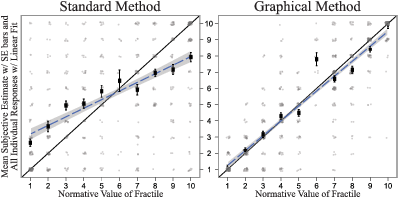
The responses from the graphical method aggregate simply to reveal the distributions that respondents saw at the start of the experiment. Figure 1 illustrates the aggregated responses (average judged frequency for each number from 1 to 10) from the graphical method (at bottom), compared to the normative distribution (at top), for all six of distributions. We make three high-level observations. First, Figure 1 reflects the aggregated-level accuracy of the lower moments (mean and variance), as well as the accuracy of higher moments like the skew. The abbreviated tails of the distributions are captured in the Floor and Ceiling distributions. The location of modes and direction of skew are accurate in the Right-of- Center (ROC) and Left-of-Center (LOC) distributions. There is rough symmetry in the Symmetrical and Uniform distributions. Of course, Figure 1 reflects the aggregated accuracy of the responses, not the individual accuracy, but later figures will show the individual-level variance is moderate. Second, while the standard method directly addresses key statistics such as fractiles, moments, and ranges, we can use the full distributions from the graphical method to derive any of these attributes. Third, the graphical method alone provides a rich 100-unit distribution for respondents and researchers to utilize, while the standard method provides only a small selection of statistics. This is particularly consequential (on both the individual and aggregate level) when the normative distributions are highly skewed or multimodal; this level of detail is missed by simple elicitations of just a few statistics.
We turn to a more quantitative analysis by comparing the graphical and standard methods in terms of accuracy for estimating fractiles of a distribution. The seven key fractiles gathered directly with the standard method are the 1st, 11th, 26th, 50th, 75th, 90th, and 100th. In the graphical method, these (and any other fractiles) can simply be read off the distribution. With the six different distributions and seven key fractiles, there are 42 normative answers, each an integer from 1 to 10. Figure 2 shows the normative values of the fractile on the x-axis and the subjective estimates on the y-axis. Exactly correct answers fall on the diagonal 45° line. We examine individual and aggregate level accuracy separately.
On the individual level, the graphical method attains higher accuracy than the standard method. Figure 2 shows all the individual responses in grey. The individual-level accuracy of the graphical method over the standard method is apparent in the lack of highly inaccurate responses for the graphical method in the upper left and lower right corners. For example, in the standard method 33% of the responses are off by 3 or more units (among the possible responses from 1 to 10), while the graphical method has just 11% off by such a large amount. Similarly, the dense gathering of responses near the diagonal with the graphical method also reflects its accuracy. The percentage of exactly correct responses nearly doubles in the graphical method compared to the standard method: 49% versus 26% exactly correct. Unsurprisingly, more accurate individual-level responses translate into a smaller average absolute error for the graphical method. The average absolute error is 2.09 units for the standard method, compared an average absolute error of 0.94 units for the graphical method. That is, the average standard method response was off by more than two units, while the average graphical response was off by less than one. Beyond statistical significance (Welch Two Sample t-test, t=−12.7, p<.001) this is a meaningful distinction as the graphical-method error is less than half the size. Narrower standard errors on the means given similar numbers of observations illustrate the lower level of dispersion of responses in the graphical method.
Figure 3: Comparison of individual-level accuracy for the 1st, 11th, 26th, 50th, 75th, 90th, and 100th fractiles, mean, and confidence range using the standard method versus graphical method. Error bars are +/- one standard error. 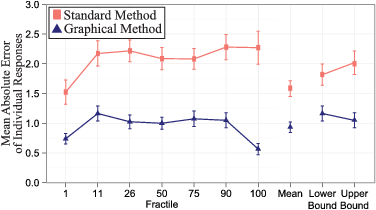
The graphical method is also more accurate on the aggregate level. The regression lines in Figure 2, based on all the individual responses, demonstrate this finding. A slope coefficient of 1 and y-intercept of 0 would indicate that the answers follow the diagonal exactly. The graphical method’s regression line has a slope 0.91 and y-intercept of 0.37. The standard method’s regression line has a slope of 0.52 and y-intercept of 2.68. As the normative answer increases by a unit, the graphical method’s estimates increase by about than one unit, while the standard method’s estimates increase by about a half of the appropriate value. Further, the means of the individual responses cluster much closer to the diagonal than the standard method’s responses. The average mean is 1.36 units from the normative answer for the standard method and 0.53 units from the normative answer for the graphical method.
The basic findings are robust to how the responses are grouped. Whereas Figure 2 showed the normative and subjective answers in terms of the normative answer values, Figure 3 shows the mean absolute error for the seven key fractiles, the mean, and confidence range for a total of 10 different outcomes.3 The mean absolute error is the individual-level error, as it shows the distance from the normative answer for any given response. The smallest difference between the graphical and standard methods is 0.79 at the 1st fractile, where the standard method’s error is still twice the graphical method’s error. The error in the standard method ranges from 87% larger (at the 11th fractile) to 302% larger (at the 100th fractile). For estimating the mean, the standard method’s error is 70% larger. For the lower and upper confidence ranges, the standard method’s errors are 56% and 92% larger, respectively.
Figure 4: Comparison of aggregated-level accuracy for the 1st, 11th, 26th, 50th, 75th, 90th, and 100th fractiles, mean, and confidence range using the standard method versus graphical method. Error bars are +/- one standard error. 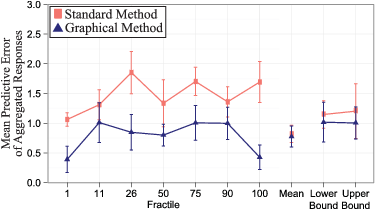
The condition where the respondents were asked to provide the “average” instead of the mean resulted in similar responses. For instance, the mean response in the “mean” condition was 5.65, while the mean response in the “average” condition was 5.62. Errors were similar as well; the standard method’s average absolute error for the “average” was 1.36 versus 1.58 for the “mean”. The median errors were identical.
Figure 5: Comparison of accuracy across the 1st, 11th, 26th, 50th, 75th, 90th, and 100th fractiles of the standard method versus graphical method, allowing for different segments of the observations. The individual-level is on the left and the aggregated-level is on the right. “100%” includes all responses. “40%” includes only the perfectly monotonic responses or the cleaned values. “40% Sample” includes a randomly sampled 40% of observations from the graphical method’s responses. 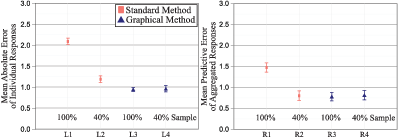
Figure 4 shows the mean aggregated-level error (i.e., predictive error) for the key statistics. Each point on the figure represents the average difference between the normative answer and the average of all of the responses for a given distribution, method, and statistic. The standard errors are much larger on this figure because, for any given fractile and statistic, there are just six values to average the error over, which correspond to the six unique distributions. Across the seven key fractiles, the overall mean from the graphical method is just 0.78 units from the normative answer, while the average mean of the standard method is 1.47 units away. Thus, the average aggregated graphical answer is 0.69 units closer to the ground truth. Again, this is not just statistically significant (Welch Two Sample t-test, t=−4.66, p<.001), but a meaningful distinction as the error from the standard method is nearly twice the size as that of the graphical method. This is not just in aggregate across all six distributions and seven fractiles, but on fractile-by-fractile basis the graphical method has consistently smaller aggregated-level errors. For the fractiles, the smallest difference in average absolute error is 0.30, but this ranges up to 1.27 with all errors being at least 30% larger (at the 11th fractile) with the standard method, and as high as 297% (at the 100th fractile). The mean and confidence bounds differences are not significant, but the graphical methods have directionally smaller errors.
Figure 6: Comparison of changes between shufflings across the 1st, 11th, 26th, 50th, 75th, 90th, and 100th fractiles, estimates of the mean and estimates of both upper and lower confidence bounds of the standard method as compared to the graphical method. “100%” includes all responses. “40%” includes only the perfectly monotonic responses or the cleaned values. 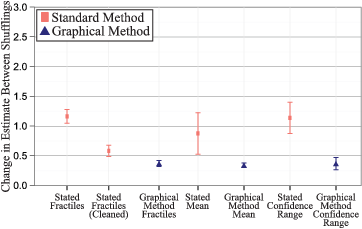
The aggregated-level errors are smaller than the comparable individual-level errors. The difference is meaningful for all statistics; Figures 3 and 4, which are both drawn to the same scale, illustrate this point. Across the six distributions and seven key fractiles the graphical method has an average error of 0.94 on the individual-level and 0.78 on the aggregated-level. The standard method has an average error of 2.09 on the aggregated-level and 1.47 on the individual level. The difference between the individual and aggregate level is larger in the standard method than the graphical method, both in terms of the size and ratio of difference.
Does the better performance of the graphical method hold when the standard method’s data are cleaned ex-post? In the standard method, subjects were asked to forecast values of seven fractiles, from 1st to 100th, in order. While the subjects are asked to provide values in order from lowest to highest, some respondents provide reversed or non-monotonic patterns of response (an issue also observed by Delavande & Rohwedder, 2008), which seems to indicate confusion. In Figure 5, we show four different data points for both the individual-level and the aggregated-level results. First, we show the overall average error for the standard methods’ stated fractiles condition. As before, this is the average absolute error for the individual-level and the average of the error of the mean for the aggregated-level. Second, we show the error for the standard method obtained after discarding the reversed or non-monotonic responses; this leaves roughly 40% of the responses. Third, we show the overall average error for the graphical methods’ seven fractiles. Finally, to compare the methods with equal numbers of usable responses, we ran a simulation in which we randomly drew 40% of the graphical method’s subjects 1,000 times and plotted the mean accuracy and its standard error.
On an individual-level, the graphical method is more accurate and cost effective than the standard method, even with ex-post help for the standard method. If we only accept responses that are monotonically increasing, the mean absolute error decreases substantially for the standard method. However, as illustrated by the left side of Figure 5, despite this ex-post cleaning, the mean absolute error for the graphical method (L3) is still smaller than that of the cleaned standard method (L2). Thus, given the same number of respondents, the cleaned standard method yields only 40% as many usable observations, which have an error that is 26% larger than that of the graphical method. To put this in perspective, a researcher spending the same amount on the standard and graphical methods would obtain 150% more usable responses with the graphical method, and attain greater accuracy as well. To compare the methods with equal numbers of usable responses, we ran a simulation in which we randomly drew 40% of the graphical method’s subjects 1,000 times. The cleaned standard method’s error (L2) is still 26% larger smaller than that of the graphical method (L4). Thus, a researcher would pay 150% more with the standard method to get the same number of usable answers and nonetheless attain worse accuracy.
Similarly, the graphical method is more efficient than the cleaned standard method on the aggregate level. Shown on the right of Figure 5, accepting only responses that are monotonically increasing, the mean predictive error decreases substantially for the standard method (R2) and becomes equal to that of the graphical method (R3). In this scenario, for the same quantity of observations a researcher can create equally accurate averages by eliminating 60% of the respondents. Note that one could also create rules to lower the error of the graphical methods’ aggregated forecast, but we did not want apply even the simplest rules ex-post to avoid any concerns about look-ahead biases. As before, we compare equal numbers of usable observations by randomly drawing 40% of the graphical method’s subjects 1,000 times in simulation. The average predictive error from that simulation (R4) is the same as the cleaned standard method’s (R2), meaning that a researcher can create an equally accurate forecast by collecting just 40% of the observations and using the graphical method.
We turn now to comparing the methods on how well they deal with irrelevant “presentation effects” that, normatively, should have no bearing on responses. The standard method was much more prone to presentation effects, which we can see by comparing results from the two different shufflings of each distribution.4 In Figure 6, we show that the differences in estimates between the two shuffles are much larger in the standard method compared to the graphical method. That is, the average response in the standard method across the seven key fractiles moves by 1.2 units (among the possible responses from 1 to 10) due to irrelevant order information, while the graphical method’s responses move by less than half a unit (0.4). Even after cleaning the standard method’s data ex-post, the graphical method is still more resistant to order effects (average movements of 0.6 vs. 0.4 units). For the mean, the differences are not only stark, as the stated mean condition has a difference of 0.9 units versus just 0.3 units for the graphical method, but the standard error is very telling. While there was a wide distribution of differences in the stated mean for the six unique distributions, the graphical method produced consistently small errors. The differences in the stated confidence range condition were very similar to the stated fractile condition. Presentation effects, therefore, may not necessarily be the result of a biased memory representation. It could be the case that accurate mental representations lead to inaccurate estimates as a side effect of stated elicitation techniques, that is, biases could be introduced at the point of linguistic expression.
Figure 7: Comparison of accuracy of the graphical methods and two different versions of the standard method. The top chart shows the mean absolute error of the ranges that are supposed to be 80 percentage points wide. The bottom chart aggregates all of the submitted confidence ranges in the category and determines the average width. “Cleaned” refers to eliminating standard method responses that are not monotonically increasing. 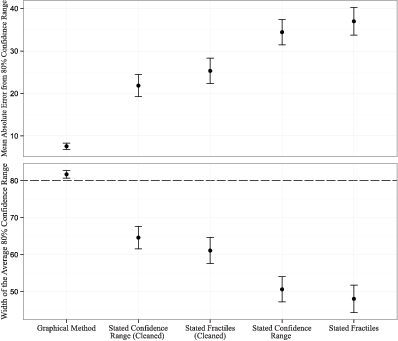
Regarding confidence, three different sets of 80% confidence ranges can be constructed from the experiment’s conditions. First, in the standard method’s confidence range condition respondents were asked for an interval that would be 80% likely to contain a single draw from the population. Second, in the standard method’s fractiles condition, subjects were asked for the 11th and 90th fractile. Third, in the graphical method, respondents specified 80% intervals (as well as many other kinds of interval) as a consequence of submitting an entire 100 unit distribution. Several potential methods can determine the density from the true distribution that falls within the high and low values provided by the respondent. We choose a simple and transparent method and find that our results seem to be robust under other methods. To determine the density that lies within the respondent’s confidence range values, we make the assumptions that are most advantageous for the respondent’s accuracy.5
On an individual level, the absolute error of the graphical method is well less than half of that of the standard method, even under ex-post cleaning and the most favorable assumptions for the standard method. At the top of Figure 7 we show the average absolute difference of the confidence range sizes compared to the normative answer (80 percentage points). For example, if the submitted confidence range has a width of 70 percentage points, its error is 10; if its width is 95 percentage points, its error is 15. The graphical method’s average error is just 8 percentage points. The next best method is the condition in which we asked directly for the confidence and we drop all non-monotonically increasing responses. The error in that condition is 22 percentage points. If we do not provide ex-post cleaning to the standard response, the difference in the error is even more dramatic, with the standard method’s absolute error of 34 percentage points. The “stated confidence range” condition is just slightly, but not significantly, more accurate than the “stated fractile” condition.
On the aggregate level, the graphical method does not suffer from the common issue of overly narrow confidence ranges that are observed with the standard method. On the bottom of Figure 7 we show the size of the average range, where the normative range size is 80 percentage points. On average, the respondents are very well calibrated using the graphical method. The bottom of Figure 7 shows that about 82% of answers fall within average graphical method response’s 80% confidence range. This stands in sharp contrast with the standard method conditions, in which only 48% (stated fractile condition) to 65% (stated confidence range, cleaned for non-monotonic responses) of answers fall within the 80% confidence ranges.
We began by noting a difference in the psychological and economic literatures concerning the statistical intuitions of laypeople. Part of this difference is likely due to an emphasis on aggregated-level accuracy in economics (the wisdom of the crowds) and individual-level accuracy in psychology. We see in our results, as one would expect, that aggregated-level estimates are more accurate. However, we also observe that accuracy varies between elicitation techniques. Both at the individual and the aggregate level, laypeople’s responses are significantly more accurate using the graphical rather than the standard method that unfortunately is most used in experimental research. This result holds across ten different measures (seven key fractiles, means, upper and lower confidence bounds), even after we apply a generous ex-post correction to the standard method. Further tests reveal that irrelevant “presentation effects” seem to be much more of a problem under the standard method. To get accurate estimates about various statistics of a subjective probability distribution, our findings suggest it may be better to elicit the entire distribution graphically and compute arbitrary statistics, rather than asking about the statistics directly.
We pause here to think about how the experiment might have turned out. Had both the standard and graphical methods exhibited strong, systematic errors and biases at the individual and aggregate levels, it could be consistent with a view that mental representations are systematically and stubbornly biased (or with the idea that we simply didn’t test a suitable elicitation method). Had the standard method turned out to be better, or had both methods turned out to be highly and equally accurate, it would have been puzzling since there is ample evidence in the literature that the standard method leads to biased estimates. Lastly, the experiment could have turned out as it did, with the graphical technique emerging as better. This result seems consistent with two possibilities. First, it could be the case that laypeople’s mental representations are fundamentally inaccurate but that the graphical elicitation method somehow corrects them in spite of the user, much like the spelling correction in a word processor causes those who do not know the spelling of a word appear as if they do. Or, second, it could be the case that underlying mental representations are accurate, but something about stated elicitation corrupts this accuracy at the point when answers are articulated. We have doubts about the first idea. While it is possible that the graphical method could create the illusion of accuracy on one or two outcome measures, we find it unlikely that it would have this strong ameliorative effect on some ten measures, presentation effects, and confidence ranges at both the individual and aggregate levels, especially after the stated method’s data have been cleaned. Furthermore, the second account seems plausible. For example, a bias we see in the stated method is that people tend to report answers that are biased towards the middle of the distribution. Note the flatter regression line in Figure 2 and the too-narrow confidence ranges in Figure 7. Since we do not observe this in the graphical method, people’s stated estimates could be biased at the moment they express them, similar to the phenomenon of anchoring on a prominent number in memory (here, the mode of the distribution).
In future work, we shall test this idea by collecting process data about how people create distributions with the graphical method. One hypothesis is that graphical method may be causing people, bit by bit, to recall (and extrapolate from) the full observed distribution rather than taking a quick sample that is biased towards the center of the distribution. This would happen if people initially retrieve values that are near the center but then, with the requirement of producing 100 values, search memory to retrieve more extreme observations. Conversely, in Figure 1 we note one asymmetry, with slightly too much weight on the lower numbers in the normatively uniformly distribution. That could be caused people starting on the lower numbers and working upward. Either working from the outside to the inside or the inside to the outside, the graphical method may just induce people to think of the full picture. By using mouse-tracking technology, we can record distributions as they are built and test whether they expand from the inside out, or from low to high values.
When responding using the standard method, respondents may use heuristics that make it seem as if they are incapable of taking a mean or providing a confidence range. This can be tested with a two-step method of having respondents attempt to define the fractiles, mean, etc., from a distribution they have first provided in the graphical method. This two-step test would disentangle the accuracy in generating future samples from accuracy in providing summary statistics.
One limitation our of experiment is that, in the real world, people make decisions on data they saw days, weeks, or months in the past, while we tested people numbers they observed only minutes ago. People could store and retrieve recent and distant stimuli differently (Lindskog et al., 2013). We assume that both methods drop off in accuracy over long time periods, but it may be the case that they do so at different rates, and this is a topic for our future research.
To conclude, we find that laypeople’s intuitions about probability distributions can be rather accurate when the graphical elicitation technique is used, a finding that brings the views from psychology and economics a bit closer together. With the increasing pervasiveness of computing power in everyday devices such as smartphones and tablets, the graphical method holds promise for improving the accuracy and efficiency of individual-level decisions and aggregate-level polls and forecasts.
Deese, J. R., & Kaufman, A. (1957). Serial effects in recall of unorganized and sequentially organized verbal material. Journal of Experimental Psychology, 54, 180–187.
Delavande, A., & Rohwedder. S. (2008). Eliciting subjective probabilities in Internet surveys. Public Opinion Quarterly, 72, 866–891.
Gigerenzer, G. (2011). What are natural frequencies? Doctors need to find better ways to communicate risk to patients. BMJ, 343:d6386. http://dx.doi.org/10.1136/bmj.d6386.
Gigerenzer, G., & Murray, D. J. (1987). Cognition as intuitive statistics. Hillsdale, NJ: Erlbaum.
Goldstein, D. G., Johnson, E. J., & Sharpe, W. F. (2008). Choosing outcomes versus choosing products: Consumer-focused retirement investment advice. Journal of Consumer Research, 35, 440–456.
Haran, U., Moore D. A., & Morewedge, C. K. (2010). A simple remedy for overprecision in judgment. Judgment and Decision Making, 5, 467–476.
Hasher, L., & Zacks, R. T. (1984). Automatic processing of fundamental information: the case of frequency of occurrence. The American Psychologist, 39, 1372–1388.
Hasher, L., & Zacks, R. T. (1979). Automatic and effortful processes in memory, Journal of Experimental Psychology: General, 108, 56–388.
Hau, R., Pleskac, T. J., & Hertwig, R. (2010). Decisions from experience and statistical probabilities: Why they trigger different choices than a priori probabilities. Journal of Behavioral Decision Making, 23, 48–68.
Hertwig, R., Barron, G., Weber, E. U., & Erev, I. (2004). Decisions from experience and the effect of rare events in risky choice. Psychological Science, 15, 534–539.
Hoffrage, U., Lindsey, S., Hertwig, R., & Gigerenzer, G. (2000). Communicating statistical information. Science, 290, 2261–2262.
Hogarth, R. M., & Einhorn, H. J. (1992). Order effects in belief updating: The belief-adjustment model. Cognitive Psychology, 24, 1–55.
Hogarth, R. M., & Soyer, E. (2011). Sequentially simulated outcomes: Kind experience vs. non-transparent description. Journal of Experimental Psychology: General, 140, 434–463.
Ibrekk, H., Morgan, & M. G. (1987). Graphical communication of uncertain quantities to nontechnical people. Risk Analysis, 7, 519–529.
Jenkinson, D. J. (2005). The elicitation of probabilities– a review of the statistical literature. BEEP working paper, University of Sheffield, UK.
Kahneman, D., Fredrickson, B. L., Schreiber, C. A., & Redelmeier, D. A. (1993). When more pain is preferred to less: Adding a better end. Psychological Science, 4, 401–405.
Kabus, I. (1976). You can bank on uncertainty, Harvard Business Review, May-June, 95–105.
Kaufmann, C., Weber, M., & Haisley, E.C. (2013). The role of experience sampling and graphical displays on one’s investment risk appetite, Management Science, 59, 323–340.
Laplace, P.-S. (1951). A philosophical essay on probabilities (F.W. Truscott & F.L. Emory, Trans.). New York: Dover. (Original work published 1814).
Lau, H., Lau, A., & Ho, C. (1998). Improved moment-estimation formulas using more than three subjective fractiles. Management Science, 44, 346—351.
Lichtenstein, S., Fischhoff, B., & Phillips, L. D. (1982). In D. Kahneman, P. Slovic and A. Tversky (Eds.), Judgment Under Uncertainty: Heuristics and Biases. Cambridge: Cambridge University Press.
Lindskog, M., Winman, A., & Juslin, P. (2013). Naïve point estimation. Journal of experimental psychology: learning, memory, and cognition, 39, 782.
Mason, W., & Suri, S. (2012). Conducting behavioral research on Amazon’s Mechanical Turk. Behavior Research Methods, 44, 1–23.
O’Hagan, A, Buck, C. E., Daneshkhah, A., Eiser, J. R., Garthwaite, P. H., Jenkinson, D. J., Oakley, J. E., & Rakow, T. (2006). Uncertain Judgments: Eliciting Experts’ Probabilities. New York: Wiley.
Peterson, C. R., & Beach, L. R. (1967). Man as intuitive statistician. Psychological Bulletin, 68, 29—46.
Sharpe, W., Goldstein, D. G., & Blythe, P. (2000). The distribution builder: A tool for inferring investor preferences. Available online at: http://www.stanford.edu/~wfsharpe/art/qpaper/qpaper.pdf.
Staël von Holstein, C.-A. S. (1971). Two techniques for assessment of subjective probability distributions — An experimental study. Acta Psychologica, 35, 478–494.
Tversky, A., & Kahneman, D. (1974). Judgment under uncertainty: Heuristics and biases. Science, 185, 1124–1130.
Wallsten, T. S., & Budescu, D. V. (1983). Encoding subjective probabilities: A psychological and psychometric review. Management Science, 29, 151—173.
Winkler, R. L. (1967). The assessment of prior distributions in Bayesian analysis. Journal of the American Statistical Association 62, 776–800.
Van Lenthe, J. (1993a). A blueprint of ELI: A new methods for eliciting subjective probability distributions. Behavior Research Methods Instruments & Computers, 25, 425–433.
Van Lenthe, J. (1993b). ELI: An interactive elicitation technique for subjective probability distributions. Organizational Behavior & Human Decision Processes, 55, 379–413.
Van Noortwijk, J. M., Dekker, A., Cooke, R. M., & Mazzuchi, T. A. (1992). Expert judgment in maintenance optimization. Reliability, IEEE Transactions on, 41, 427–432.
Imagine we have an extremely large bag of ping pong balls. Each ball has a value between 0 and 10 written on it. We will randomly choose 100 balls from the bag.
On the next screen we will show you their values, one at a time, very quickly. This will take about a minute.
Say each value to yourself as it passes before your eyes; try to remember as much as you can.
Please answer the below question and then Press Continue to Start.
Say each number to yourself as it flashes past!

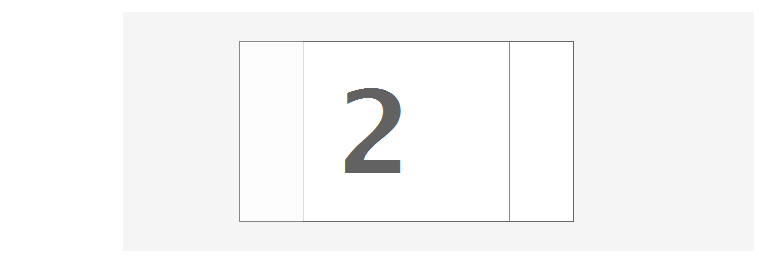


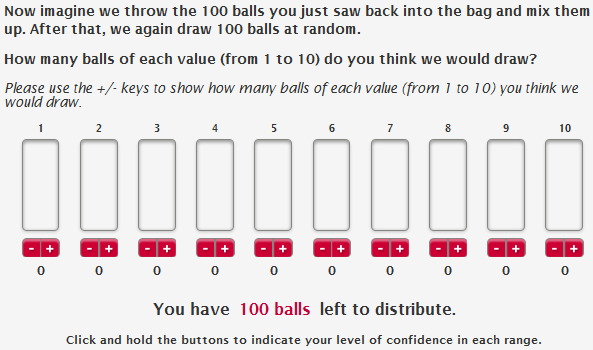
Now imagine we throw the 100 balls you just saw back into the bag and mix them up. After that, we again draw 100 balls at random.
Imagine the new set of 100 balls were arranged in front of you with the smallest values on the left and the largest values on the right. What do you think would be the value of the 1st ball from the left?
Since each ball has a value from 1 to 10, your answer should be between 1 and 10.
What do you think would be the value of the 11th ball from the left?
What do you think would be the value of the 26th ball from the left?
What do you think would be the value of the 50th ball from the left?
What do you think would be the value of the 75th ball from the left?
What do you think would be the value of the 90th ball from the left?
What do you think would be the value of the 100th ball from the left?
Now imagine we throw the 100 balls you just saw back into the bag and mix them up. After that, we again draw 100 balls at random.
In statistics, the mean of 100 values is the number you would get by adding up all the values and dividing by 100. What do you think is the mean of the 100 new values drawn?
Since each ball has a value from 1 to 10, your answer should be between 1 and 10.
Now imagine we throw the 100 balls you just saw back into the bag and mix them up. After that, we again draw 100 balls at random.
What do you think is the average of the 100 new values drawn?
Since each ball has a value from 1 to 10, your answer should be between 1 and 10.
Now imagine we throw the 100 balls you just saw back into the bag and mix them up. After that, we draw 1 ball at random.
I am 90% certain the value of this ball would be greater than or equal to:
I am 90% certain the value of this ball would be less than or equal to:
This document was translated from LATEX by HEVEA.